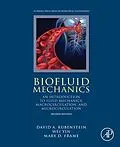Uses language and math that is appropriate and conducive for undergraduate learning, containing many worked examples and end-of-chapter problems
Develops all engineering concepts and equations within a biological context
Covers topics in the traditional biofluids curriculum, and addresses other systems in the body that can be described by biofluid mechanics principles
Discusses clinical applications throughout the book, providing practical applications for the concepts discussed
NEW: Additional worked examples with a stronger connection to relevant disease conditions and experimental techniques
NEW: Improved pedagogy, with more end-of-chapter problems, images, tables, and headings, to better facilitate learning and comprehension of the material
Autorentext
Dr. Rubenstein focuses on two major research areas: vascular tissue engineering and the initiation/progression of cardiovascular diseases mediated through platelet and endothelial cell interactions.
Leseprobe
Chapter 1 Introduction
This textbook will discuss basic fluid mechanics principles, flows within the macrocirculation, flows within the microcirculation, specialty circulations, and experimental techniques common to biofluid mechanics. The National Institutes of Health working definition of biomedical engineering states, "Biomedical engineering integrates physical, chemical, mathematical, and computational sciences and engineering principles to study biology, medicine, behavior, and health. It advances fundamental concepts; creates knowledge from the molecular to the organ systems level; and develops innovative biologics, materials, processes, implants, devices and informatics approaches for the prevention, diagnosis, and treatment of disease, for patient rehabilitation, and for improving health." The focus of this textbook is biofluid mechanics, which is concerned with how biological systems interact with and/or use liquids/gases. For humans, this includes obtaining and transporting oxygen, maintaining body temperature, and regulating homeostasis.
KeywordsBiomedical engineering; biofluid mechanics; cardiovascular diseases; dimensions; units
Learning Outcomes1. Identify basic engineering skills that will be used in this course
2. Describe the fields and the importance of biomedical engineering, fluid mechanics, and biofluid mechanics
3. Review concepts of dimensions and units
4. Discuss two of the salient dimensionless numbers in biofluid mechanics
1.1 Note to Students about the TextbookThe goal of this textbook is to clearly describe how fluid mechanics principles can be applied to different biological systems and, in parallel, discuss current research avenues in biofluid mechanics and common pathological conditions that are associated with altered biofluids, biofluid flows, and/or biofluid organs. Classic fluid mechanics laws, which the reader may be familiar with from a previous course in fluid mechanics (but will be reviewed in Part 1 of this textbook), have been used extensively to describe blood flow through the vascular system for decades. One major goal of this textbook is to discuss how these laws apply to the vascular system, but we also aim to highlight some of the specialty flows that can be described using the same fluid mechanics principles. Part 2, Macrocirculation, and Part 3, Microcirculation, focus on the application of these classic principles to the vascular system and develop mathematical formulas and relationships to help the reader understand the fluid mechanics associated with blood flow through blood vessels of various sizes. Part 4, Specialty Circulations, describes fluid flows through the lungs, eyes, diarthroses joints, kidneys, and the splanchnic circulation, which are not traditionally covered in biofluid mechanics courses but are very important biological flows in the human body. Note that there are other important specialty circulations, which can be modeled using the fluid mechanics principles that will be developed in Part 1 of this textbook. We may touch on some of those circulations, but we will not fully develop an analysis of these flows. For the most part, similar fluid mechanics principles can be used to describe the specialty circulations with some slight modifications to accurately depict the particular special conditions associated with the circulation. Part 5, Experimental Techniques, briefly highlights different procedures that are currently being used in biofluid mechanics laboratories to elucidate flow characteristics. At the same time, we will highlight some of the current innovative work that is being conducted to elucidate biofluid mechanics phenomena. The overarching goal of this textbook is to establish a foundation for students' future studies in biofluid mechanics, whether in a more advanced course or in a research environment
Inhalt
Part 1: Fluid Mechanics Basics Fundamentals of Fluid Mechanics Conservation Laws
Part 2: Macrocirculation The Heart Blood Flow in Arteries and Veins
Part 3: Microcirculation Microvascular Beds Mass Transport and Heat Transfer in the Microcirculation The Lymphatic System
Part 4: Specialty Circulations Ventilation/Perfusion in the Lung Intraocular Fluid Flow Lubrication of Joints and Transport in Bone Flow Through the Kidney Splanchnic Circulation: Liver and Spleen
Part 5: Modeling and Experimental Techniques In silico Biofluid Mechanics In vitro Biofluid Mechanics In vivo Biofluid Mechanics
Further Readings
Index
